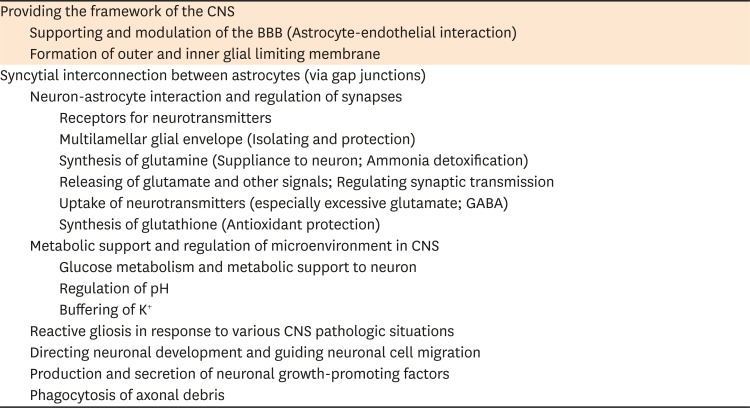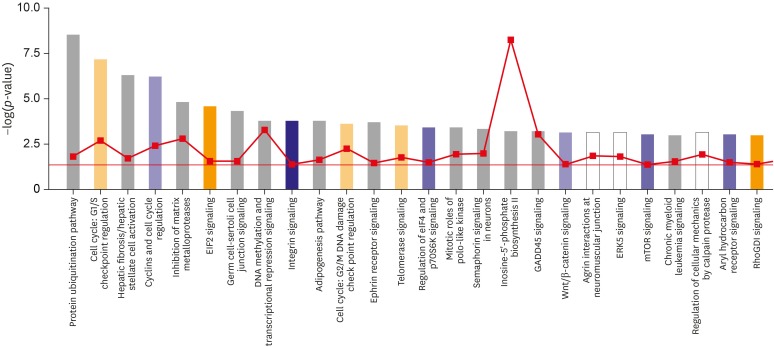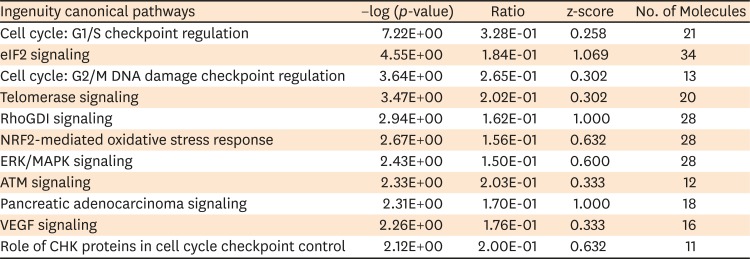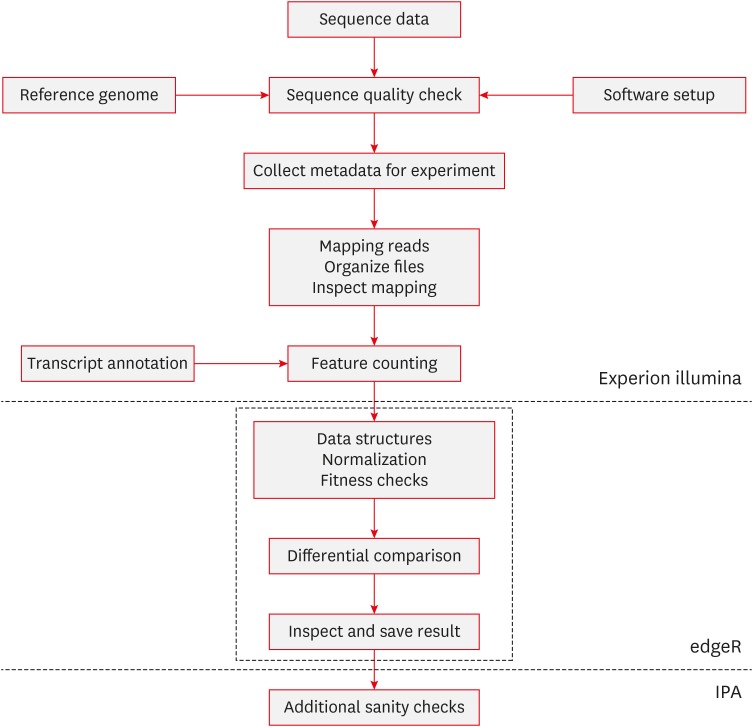1. Abbott NJ, Rönnbäck L, Hansson E. Astrocyte-endothelial interactions at the blood-brain barrier. Nat Rev Neurosci. 7:41–53. 2006; PMID:
16371949.

2. Anders S, McCarthy DJ, Chen Y, Okoniewski M, Smyth GK, Huber W, et al. Count-based differential expression analysis of RNA sequencing data using R and Bioconductor. Nat Protoc. 8:1765–1786. 2013; PMID:
23975260.

3. Banerjee S, Crouse NR, Emnett RJ, Gianino SM, Gutmann DH. Neurofibromatosis-1 regulates mTOR-mediated astrocyte growth and glioma formation in a TSC/Rheb-independent manner. Proc Natl Acad Sci U S A. 108:15996–16001. 2011; PMID:
21896734.

4. Benarroch EE. Neuron-astrocyte interactions: partnership for normal function and disease in the central nervous system. Mayo Clin Proc. 80:1326–1338. 2005; PMID:
16212146.

5. Brenner S, Johnson M, Bridgham J, Golda G, Lloyd DH, Johnson D, et al. Gene expression analysis by massively parallel signature sequencing (MPSS) on microbead arrays. Nat Biotechnol. 18:630–634. 2000; PMID:
10835600.

6. Clemens MJ. Translational regulation in cell stress and apoptosis. Roles of the eIF4E binding proteins. J Cell Mol Med. 5:221–239. 2001; PMID:
12067482.

7. Clevers H, Nusse R. Wnt/β-catenin signaling and disease. Cell. 149:1192–1205. 2012; PMID:
22682243.

8. Dazert E, Hall MN. mTOR signaling in disease. Curr Opin Cell Biol. 23:744–755. 2011; PMID:
21963299.

9. Dovas A, Couchman JR. RhoGDI: multiple functions in the regulation of Rho family GTPase activities. Biochem J. 390:1–9. 2005; PMID:
16083425.

10. Etienne-Manneville S, Hall A. Integrin-mediated activation of Cdc42 controls cell polarity in migrating astrocytes through PKCzeta. Cell. 106:489–498. 2001; PMID:
11525734.
11. Fields RD, Stevens-Graham B. New insights into neuron-glia communication. Science. 298:556–562. 2002; PMID:
12386325.

12. Fukata M, Nakagawa M, Kaibuchi K. Roles of Rho-family GTPases in cell polarisation and directional migration. Curr Opin Cell Biol. 15:590–597. 2003; PMID:
14519394.

13. Hatton GI. Glial-neuronal interactions in the mammalian brain. Adv Physiol Educ. 26:225–237. 2002; PMID:
12443995.

14. Kiernan JA. Barr's the human nervous system: an anatomical viewpoint. ed 9. Philadelphia, PA: Lippincott Williams & Wilkins;2008.
15. Kimelberg HK. Primary astrocyte cultures--a key to astrocyte function. Cell Mol Neurobiol. 3:1–16. 1983; PMID:
6136326.

16. Kimelberg HK, Bowman C, Biddlecome S, Bourke RS. Cation transport and membrane potential properties of primary astroglial cultures from neonatal rat brains. Brain Res. 177:533–550. 1979; PMID:
227541.

17. Kim SU. Human neural stem cells genetically modified for brain repair in neurological disorders. Neuropathology. . 24:159–171. 2004; PMID:
15484694.

18. Kim SU, de Vellis J. Stem cell-based cell therapy in neurological diseases: a review. J Neurosci Res. 87:2183–2200. 2009; PMID:
19301431.

19. Kim SU, Nagai A, Nakagawa E, Choi HB, Bang JH, Lee HJ, et al. Production and characterization of immortal human neural stem cell line with multipotent differentiation property. Methods Mol Biol. 438:103–121. 2008; PMID:
18369753.

20. Kim WK, Kim D, Cui J, Jang HH, Kim KS, Lee HJ, et al. Secretome analysis of human oligodendrocytes derived from neural stem cells. PLoS One. 9:e84292. 2014; PMID:
24392122.

21. Kuffler SW. Neuroglial cells: physiological properties and a potassium mediated effect of neuronal activity on the glial membrane potential. Proc R Soc Lond B Biol Sci. 168:1–21. 1967; PMID:
4382871.
22. Nagai A, Nakagawa E, Hatori K, Choi HB, McLarnon JG, Lee MA, et al. Generation and characterization of immortalized human microglial cell lines: expression of cytokines and chemokines. Neurobiol Dis. 8:1057–1068. 2001; PMID:
11741401.

23. Pekny M, Nilsson M. Astrocyte activation and reactive gliosis. Glia. 50:427–434. 2005; PMID:
15846805.

24. Ridet JL, Malhotra SK, Privat A, Gage FH. Reactive astrocytes: cellular and molecular cues to biological function. Trends Neurosci. 20:570–577. 1997; PMID:
9416670.

25. Roux PP, Blenis J. ERK and p38 MAPK-activated protein kinases: a family of protein kinases with diverse biological functions. Microbiol Mol Biol Rev. 68:320–344. 2004; PMID:
15187187.

26. Singh I. Textbook of human neuroanatomy. ed 8. New Delhi: Jaypee Brothers Publishers;2006.
27. Schuster SC. Next-generation sequencing transforms today's biology. Nat Methods. 5:16–18. 2008; PMID:
18165802.

28. Vernadakis A. Neuron-glia interrelations. Int Rev Neurobiol. 30:149–224. 1988; PMID:
3061968.
29. Vernadakis A. Glia-neuron intercommunications and synaptic plasticity. Prog Neurobiol. 49:185–214. 1996; PMID:
8878303.

30. Yu FX, Guan KL. The Hippo pathway: regulators and regulations. Genes Dev. 27:355–371. 2013; PMID:
23431053.

31. Zechner D, Fujita Y, Hülsken J, Müller T, Walther I, Taketo MM, et al. β-Catenin signals regulate cell growth and the balance between progenitor cell expansion and differentiation in the nervous system. Dev Biol. 258:406–418. 2003; PMID:
12798297.

32. Zhou X, Lindsay H, Robinson MD. Robustly detecting differential expression in RNA sequencing data using observation weights. Nucleic Acids Res. 42:e91. 2014; PMID:
24753412.









 PDF
PDF ePub
ePub Citation
Citation Print
Print




 XML Download
XML Download